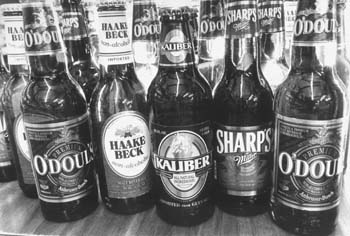
Robert Scheer
No Buzzing Allowed: Nonalcoholic beer may have a reputation for being little more than 'beer-flavored water,' but a new crop is as rich, flavorful and expensive as any microbrew.
Nonalcoholic beers are not created equal, as we discover by descending into a froth of faux firewater
By Christina Waters
YOU'RE FACING a long drive home at the end of the evening, and you don't want to drink much alcohol with dinner. On the other hand, your taste buds recoil at the idea of partnering the fine foods at that holiday buffet with a Diet Pepsi--or worse, with palate-deadening orange juice. Well, as everybody knows by now, you can find a nonalcoholic beer--but probably no more than one--listed on most restaurant menus these days. Like many fans of real beer, I have labored long under the delusion that nonalcoholic beers were all equal--and all equally tasteless.
Not so. It's just that most restaurants don't do much homework on nonalcoholic beers and just stock the ubiquitous Clausthaler or whatever their distributor is peddling. In an effort to discover whether something better was available, I hit my local liquor store, plus a Safeway, and came up with a tasting menu of nine NA products--four domestic, five imported. The results of a tasting were eye-opening.
According to Scott Voss, administrator of the Institute for Brewing Studies in Boulder, Colo., beer can lose its alcohol primarily in two ways. "The main way is to heat the product under a vacuum, distilling out the alcohol," Voss says. "Alcohol is volatile and can come out of a solution under heat. But this process does alter the flavor."
The second method, used by Anhauser-Busch in the making of O'Doul's, is a membrane filtration process that passes the beer through a membrane under pressure, in a sense filtering out the alcohol "and keeping much more of the flavor intact," according to Voss. The reason why more microbreweries don't jump on the NA bandwagon, says Voss, is the very high price of both of these alcohol-removal systems.
OK, so let's see what our tasting yielded. The good news is that you can find most of the nine beers sampled--if you look hard--in major supermarkets. The bad news is that they're as expensive as any microbrew, running well over $6 a six-pack.
In general--no surprise here--the imports fared much better and looked much richer than their American cousins. In fact, Heinz, an old Austrian hophead and one of my tasters, admitted that the American versions were "appalling" and tasted like "beer-flavored water." Charlie believed the problem lay in these beers' "fundamental epistemological problem--they're trying to imitate beer, and they're only permitted a narrow range of expression." Indeed.
Here's our ranking from the top down.
- Buckler, by Heineken, won for its true, rounded pilsner flavor and real beer acceptability, though one taster detected a "soapy" finish on the first go-'round.
- Kaliber, by Guinness, was a close second, nutty, mellow and convincing--"definitely drinkable."
- Haacke, by Beck's, also was close to the top, with "real presence" and a dry, crisp finish.
- St. Pauli Girl NA offered modest but good flavor that we described as an "inoffensive neutrality."
- Clausthaler was acceptable, definitely weak but still detectably pilsner in flavor, i.e. sort of beerlike.
- O'Doul's we characterized as having some dignity but not much flavor--Heinz thought its flavor was invisible.
- Coors NA was undrinkable in the opinion of all three tasters--"sour, rancid at the back of the palate, not beer."
- Sharp's was pathetic--"poor excuse for anything drinkable" and "so noncommittal it is absent."
- Old Milwaukee finished in the cellar and was ridiculed variously as "not even close to beer," "very, very wimpy" and having a taste "so remote it might be happening in a neighboring state."
Make no mistake, none of these will threaten the richness of Bass Ale or Harp Lager. But many of them have surprising flavor and provide more beer satisfaction than you ever thought possible. As with all libations suffering from diminished flavor, serve these beers as cold as the laws of physics--and your refrigeration unit--will allow.
[ Metro | Metroactive Central | Archives ]
![[Metroactive Dining]](/dining/gifs/dining468.gif)